Greek euro coins feature a unique design for each of the eight coins. They were all designed by Georgios Stamatopoulos with the minor coins depicting Greek ships,
the middle ones portraying famous Greeks and the two large denominations showing images of Greek history and mythology.
All designs feature the 12 stars of the EU, the year of imprint and a tiny symbol of the Bank of Greece. Uniquely,
the value of the coins is expressed on the national side in the Greek alphabet, as well as being on the common side in the Roman alphabet.
The euro cent is known as the lepto (λεπτό; plural lepta, λεπτά) in Greek.
Greece did not enter the eurozone until 2001 and was not able to start minting coins as early as the other eleven member states,
so a number of coins circulated in 2002 were not minted in Athens but in Finland (€1 and €2 – mint mark S), France (1c, 2c, 5c, 10c and 50c – mint mark F)
and Spain (20c - mint mark E). The coins minted in Athens for the euro introduction in 2002 as well as all the subsequent Greek euro coins do not carry any mint mark.
Greek euro coinage - Obverse side
| € 0.01 |
€ 0.02 |
€ 0.05 |
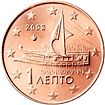 |
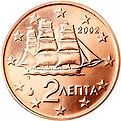 |
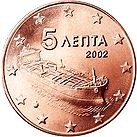 |
| An Athenian trireme of the 5th century BC |
A corvette (or dromon) of the early 19th century |
A modern tanker, symbol of Greek enterprise |
| € 0.10 |
€ 0.20 |
€ 0.50 |
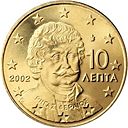 |
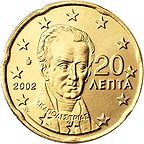 |
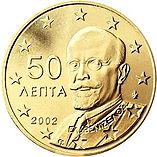 |
| Rigas Feraios, Greek writer and revolutionary |
Ioannis Kapodistrias, Greece's first statesman |
Eleftherios Venizelos, Greek politician |
| € 1.00 |
€ 2.00 |
€ 2 Coin Edge |
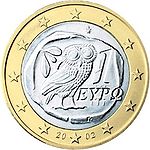 |
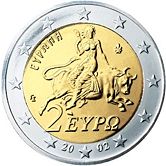 |
The words Hellenic Republic in Greek script (ΕΛΛΗΝΙΚΗ ΔΗΜΟΚΡΑΤΙΑ) |
| Picture of a 5th century BC 4 drachma coin of Athens (a coin in a coin) |
The abduction of Europa by Zeus in the form of a bull |
























